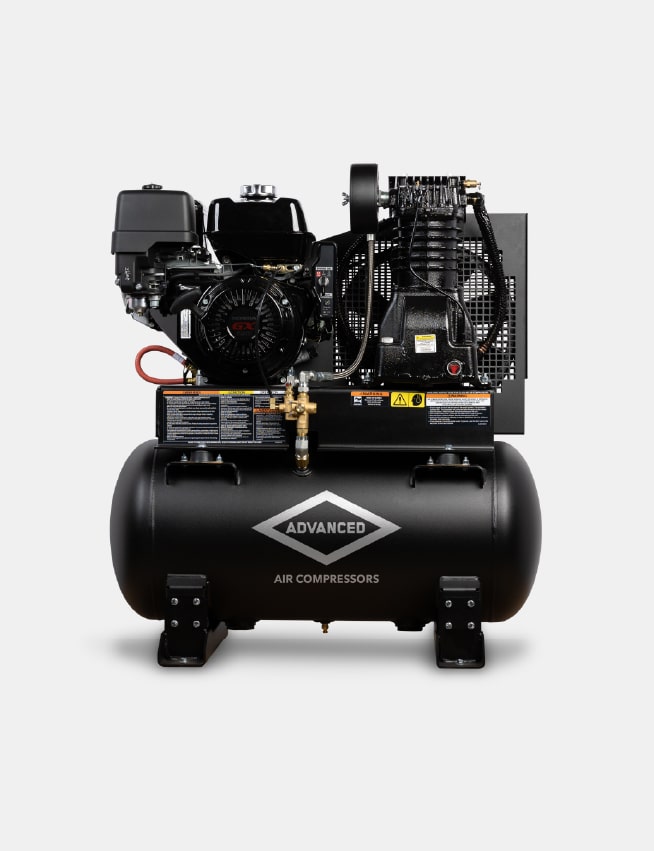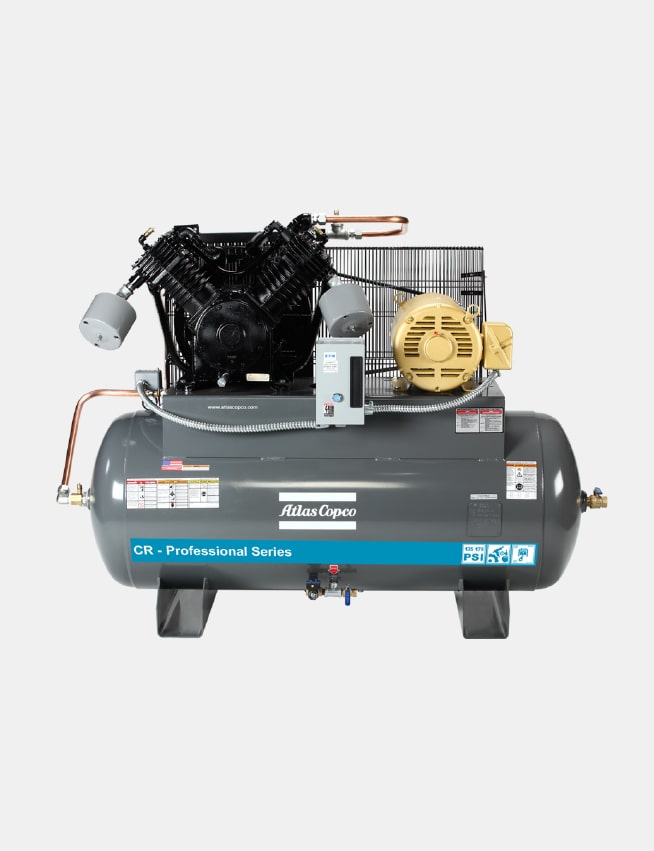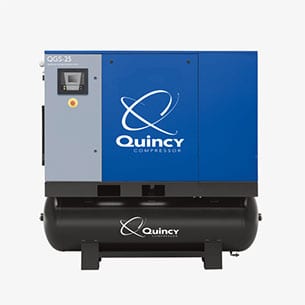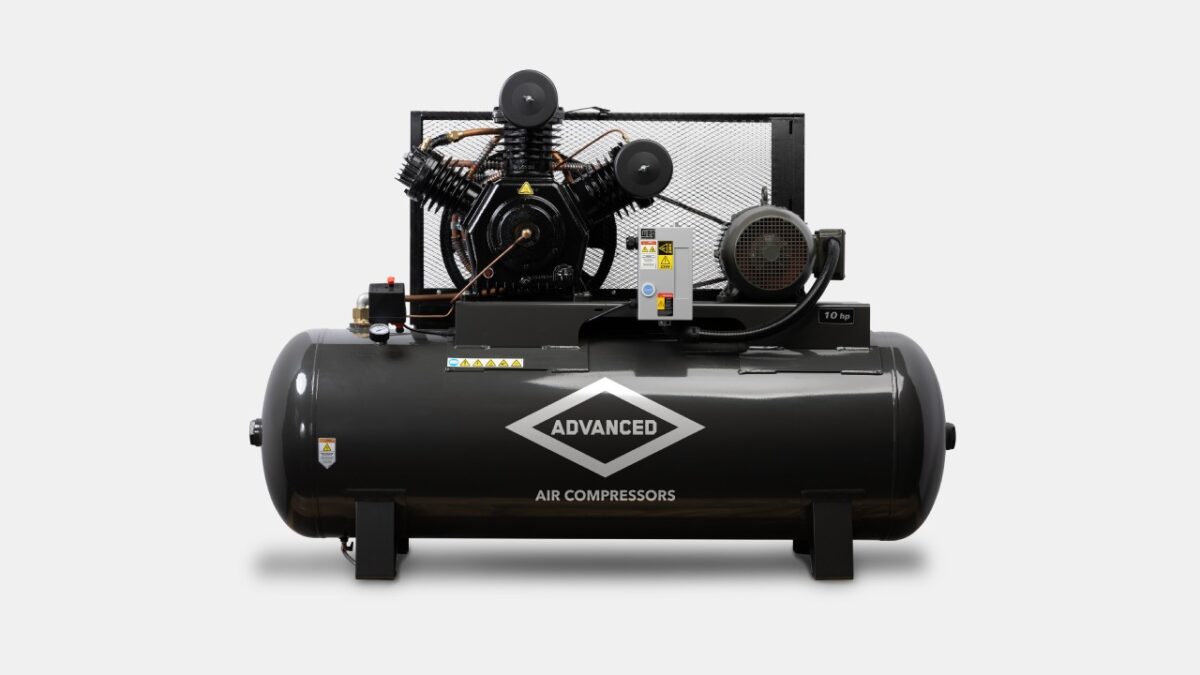If there’s one thing that’s constant about air compressors, it’s that their classifications are many and diverse. You could sort by storage tank size, electric motor horsepower, electrical phase, maximum airflow, maximum pressure, and many others. Among the other classifications is a single stage compressor versus a two-stage air compressor. What exactly is the difference between these two types of compressors, and does it really make that big of a difference to your operation? In this article, we’ll discuss the biggest differences between the compressor types, in which situations a single- or dual-stage compressor may be more effective, and pricing differences you can expect to see from air compressors that have otherwise very similar specifications.
The Main Differences

Let’s start out with what makes a single stage air compressor different from a two-stage unit: their stages. Generally speaking, you can tell this very quickly by looking at the piston system at the top of the air compressor. In a single-stage air compressor, air is drawn into the piston until it’s at full capacity, then pushed into a higher pressure and moved into the storage tank, reaching a top pressure of between 110-145 PSI. A two-stage air compressor starts out the same way, but before the compressed air is pushed into storage, it’s moved to a second compression using a smaller piston, where an additional step allows it to reach higher pressure yet to about 175 PSI. Because it’s under higher pressure, it can store more air at atmospheric pressure in cubic feet using the same sized tank when it reaches full capacity compared to its single-stage counterparts.
However, simply looking at the air compressor may not tell you enough about the machinery’s potential. Some single-stage air compressors will use two pistons on top, with one filling as the other empties into the tank. The smaller cylinder tends to be the main giveaway for a two-stage air compressor, as it shows that the initial compressed air does not take up as much room as it did prior to compression. The two stages that are being referred to are the two separate compression processes that take place in a dual-stage air compressor system, providing you with higher air pressure in the end and more storage in limited space.
Another indicator to look for is a cooling system between the two pistons. Because of the additional amount of compression that must take place, the temperature of the air can go up significantly. To avoid possible mechanical problems from this heat, high-quality two-stage air compressors will have an intercooler that will cool the air between compressions. This helps cool the mechanical parts and prevent damage from overheating.
In most situations, single stage compressors will be used in portable applications and are typically hooked up to 120V outlet systems. By comparison, two-stage systems generally are permanent installations that usually require 240V power, though the rare one may take 120V at 20 amps, providing a significantly different plug compared to standard household outlets. Single stage air compressors will also often be lighter weight, making them popular for construction and other temporary job sites. Two-stage systems are much heavier, requiring mechanical assistance to move, which is why they are typically used in permanent locations.
Uses for Single Stage and Two Stage

Though a single stage air compressor may seem like it has fewer moving parts and, therefore, is more reliable, this often isn’t the case. Typically designed for single-user operations as well as homeowner and very light business use, single stage air compressors often fail more quickly because they are not designed for constant duty and continuous applications. In these situations, it’s very easy to get caught up in work and go over the compressor’s rated duty cycle, causing overheating and a shorter lifespan overall.
When you use an air tool or multiple tools in your business, you’ll have a particular range of PSI and flow that you’ll need to meet. Depending on the different types of applications and usage you’re putting your compressor through, you may be able to get by with a single stage system, provided that you have a long enough duty cycle that the air compressor can rest on occasion. If your air compressor is constantly running or struggling to keep up with demand for compressed air in your situation, you may want to consider moving to a two-stage system.
However, that’s not the only reason to make the change. As a whole, two-stage air compressor systems tend to be significantly hardier, as they are built for higher pressures and harder work. This is among the reasons why they will often feature an intercooler to help prevent mechanical breakdown. They’re a great option for medium-sized shops that have not yet gone to rotary compressors which can work continuous duty cycles. They typically have larger tanks, allowing them to store more pneumatic energy for continuous applications. They’re also energy efficient, allowing you to get more work done with a lower cost of electricity, propane, or natural gas.
Typically available as oil-filled compressors, you’ll still need to undertake basic maintenance, such as semi-annual, quarterly, or monthly oil changes, but because dual-stage air compressor systems are designed to have longer duty cycles and higher pressures, you’ll find that they can operate much more effectively than single stage air compressor systems, while their tough build makes them last much longer in most situations.
What is the Pricing Like?

So what kind of difference can you expect to see in terms of pricing between single stage and a dual stage compressor systems? As you might expect, there is a much higher level of engineering that goes into dual-stage compressors, mainly due to the higher pressure that they undergo, as well as the fact that it has more components compared to their single-stage counterparts. However, there are often many other aspects that should be taken into account. For this reason, we’ve selected two of our most similar air compressors, one of which is a single-stage and the other of which is a dual-stage system.
Single Stage: The Quincy 12126VPQ Vertical & Portable Air Compressor $1,350
As one of the few single-stage air compressors that we have, the 12126 has a 26-gallon storage tank and can reach up to 135 PSI. It features a two-horsepower electric motor that plugs into a standard household outlet, and the wheels display its portability, making it a decent option for construction sites and shops where your compressor must be moved around the shop space. It is, however, much closer to the weight you’d perhaps expect from a permanent compressor at 165 pounds, with a powder-coated ASME tank, as we’ll see on our next example.
Dual Stage: The Quincy QT-54 Vertical Air Compressor $2,925
By comparison, one of our smallest Quincy dual-stage compressors, the QT-54, has a 60-gallon storage tank capable of reaching up to 175 PSI. A sturdy five-horsepower electric motor requires a 230V outlet to manage its workload, and there are no wheels on this 475 pound permanent lightweight. Though it’s on the small side of permanent two-stage air compressors, it will provide plenty of pneumatic power for shops, but will not be taken out to temporary job sites often.
As you can see, the pricing between these two models is fairly different, with the dual-stage compressor rating a much higher investment. However, it will also last longer, can store significantly more air in its storage tank, is built for higher pressure, and is designed for hard work over many years. For this reason, it makes a much better investment than the single stage, which may be replaced several times before the dual stage reaches its end of life.
Though you’ll have to decide whether a single- or dual-stage system is best for your situation and bearing in mind that this does not include rotary screw compressor systems, either type of compressor could provide you with excellent results. However, for most professional situations that do not involve individual air compressors at workstations, we recommend stepping up to a high-quality dual-stage air compressor for industrial work, as it will combine the higher pressure, longer lifespan, and superior energy efficiency you’ll need in continuous applications.
Are you ready to make a change in your business to improve the operation of your industrial air compressor? Advanced Air & Vacuum has years of experience helping companies find the right solutions to their issues, from humidity levels causing corrosion to compressed air lines needing upgrading. If you’re ready to take the next step, please feel free to reach out today with any questions, for more details, or for help finding solutions that meet your company’s needs.

